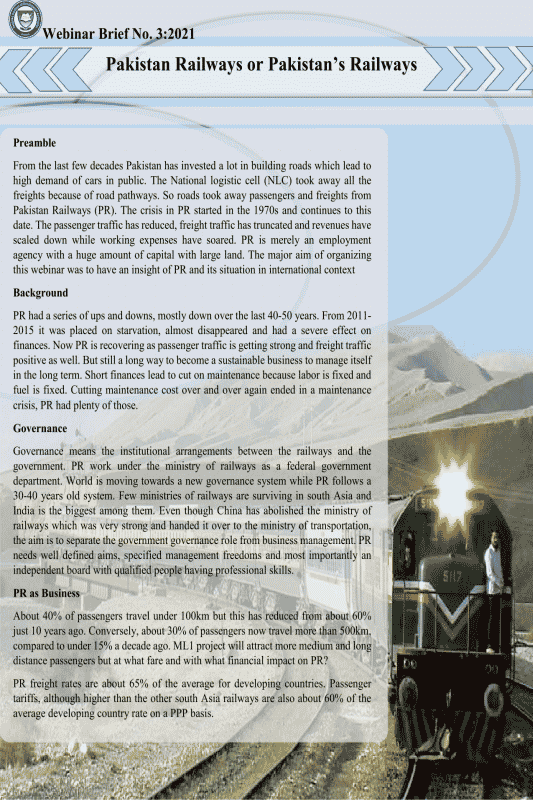
Pakistan Institute of Development Economics
- Home
Our Portals
MenuMenuMenuMenuMenuMenuMenu - ResearchMenuMenuMenuMenuMenuMenuMenu
- Discourse
- The PDR
- Our Researchers
- Academics
- Degree Verification
- Thesis Portal
- Our Portals
Pakistan Railways Or Pakistan’S Railways
Pakistan Railways or Pakistan’s Railways
Preamble
From the last few decades Pakistan has invested a lot in building roads which lead to high demand of cars in public. The National logistic cell (NLC) took away all the freights because of road pathways. So roads took away passengers and freights from Pakistan Railways (PR). The crisis in PR started in the 1970s and continues to this date. The passenger traffic has reduced, freight traffic has truncated and revenues have scaled down while working expenses have soared. PR is merely an employment agency with a huge amount of capital with large land. The major aim of organizing this webinar was to have an insight of PR and its situation in international context
Background
PR had a series of ups and downs, mostly down over the last 40-50 years. From 2011-2015 it was placed on starvation, almost disappeared and had a severe effect on finances. Now PR is recovering as passenger traffic is getting strong and freight traffic positive as well. But still a long way to become a sustainable business to manage itself in the long term. Short finances lead to cut on maintenance because labor is fixed and fuel is fixed. Cutting maintenance cost over and over again ended in a maintenance crisis, PR had plenty of those.
Governance
Governance means the institutional arrangements between the railways and the government. PR work under the ministry of railways as a federal government department. World is moving towards a new governance system while PR follows a 30-40 years old system. Few ministries of railways are surviving in south Asia and India is the biggest among them. Even though China has abolished the ministry of railways which was very strong and handed it over to the ministry of transportation, the aim is to separate the government governance role from business management. PR needs well defined aims, specified management freedoms and most importantly an independent board with qualified people having professional skills.
PR as Business
About 40% of passengers travel under 100km but this has reduced from about 60% just 10 years ago. Conversely, about 30% of passengers now travel more than 500km, compared to under 15% a decade ago. ML1 project will attract more medium and long distance passengers but at what fare and with what financial impact on PR?
PR freight rates are about 65% of the average for developing countries. Passenger tariffs, although higher than the other south Asia railways are also about 60% of the average developing country rate on a PPP basis.
Labor in PR is improved as employment has fallen and as traffic units have increased. India with its heavy freight traffic and well loaded passenger services have highest labor productivity in south Asia but there are also many worse than PR.
The revenue from passenger services is more than operating cost but not enough to cover the depreciation. Thus, it is unable to contribute anything to the cost of infrastructure if it is to continue as a long-term business.
The revenue from freight services its operating cost as well as the depreciation that ensure its long-term sustainability. It is also possible to contribute a small amount to the cost of infrastructure. This arrangement works when both are in public-sector will become difficult as private operators appear.
Pensions are a very large amount (about 30 billion in 2017-18), 10% higher than the actual wage bill, as they are being paid to previous employees. If they only needed to cover current employees the cost would probably be closer to Rs5 billion only.
Recommendations
A robust PR is a must for the growth rate of 5 to 6 %.
Public governance needs to develop new policies and railways law to structure PR for the 21st century. A good management and PR structure to be built, in order to increase real skills. Funding framework and transport operations need insight improvement as well.
Automatic monitoring systems should be developed as we are using old instruments where a person inspects tracks manually, 70% revenue is consumed in salaries where the right operational budget is only 10%.
The ML1 will increase the capacity of the railway tracks from 32 trains each way in 24 hours to 170 trains.it will bring the manpower in full swing.
Assets like infrastructure, the rolling stock and the human resource must be used efficiently to operate train operations.



